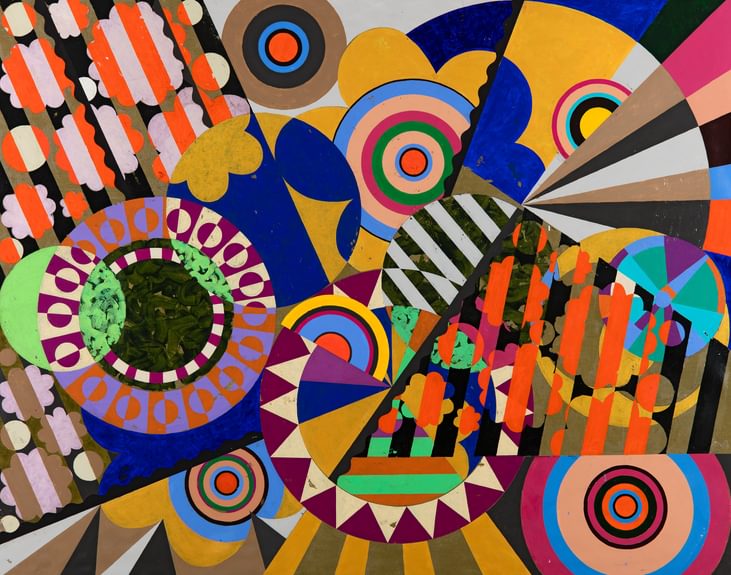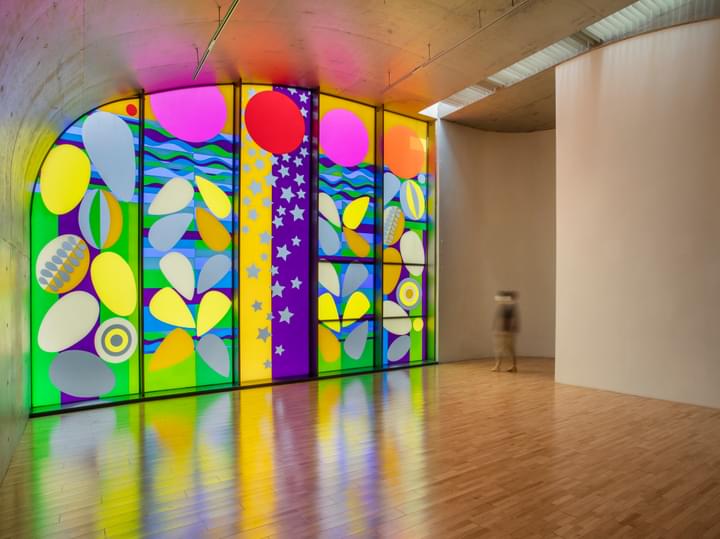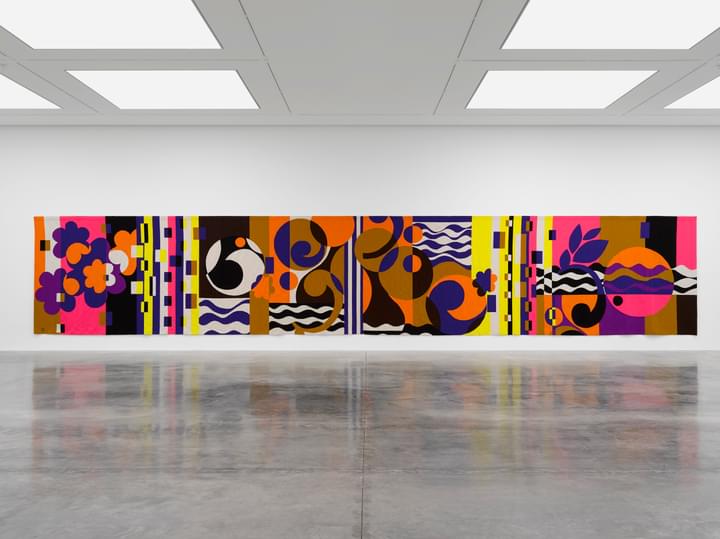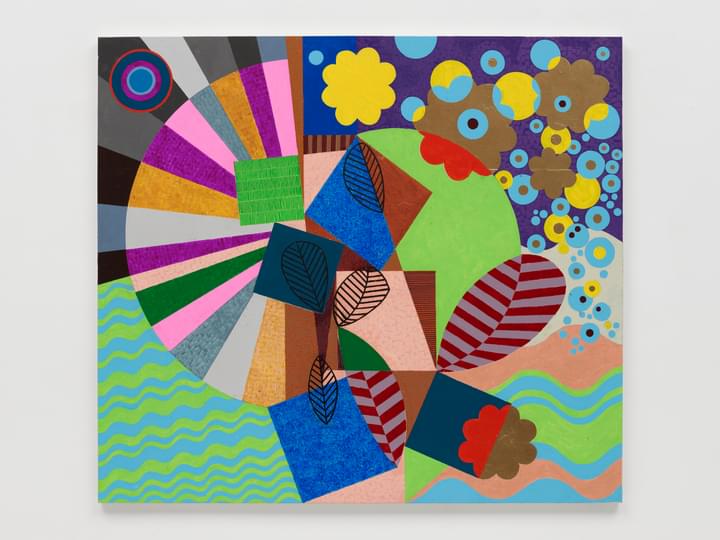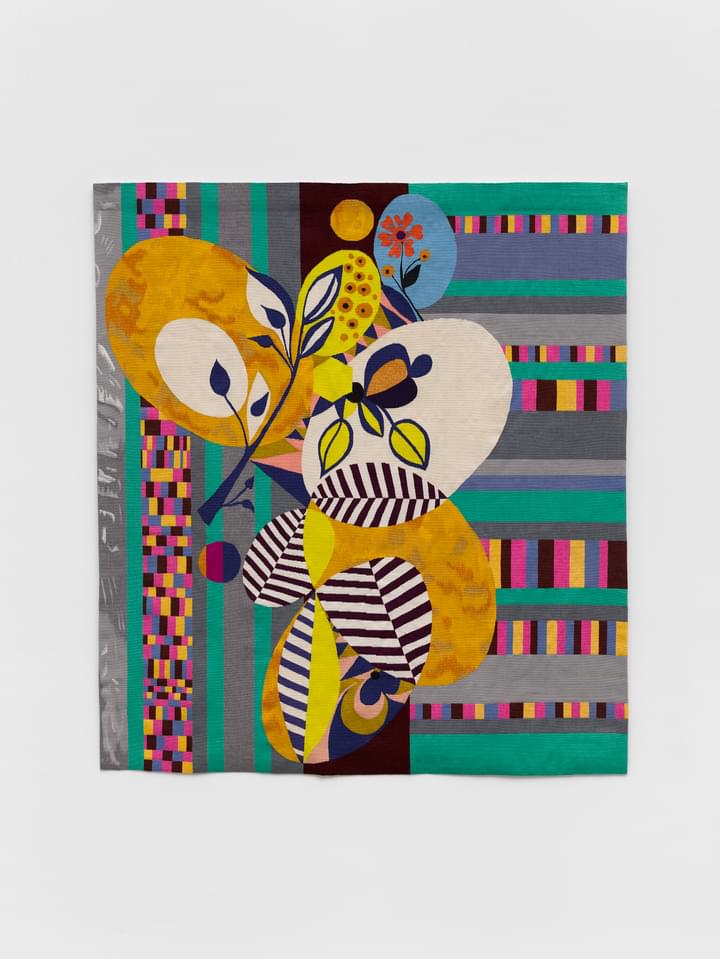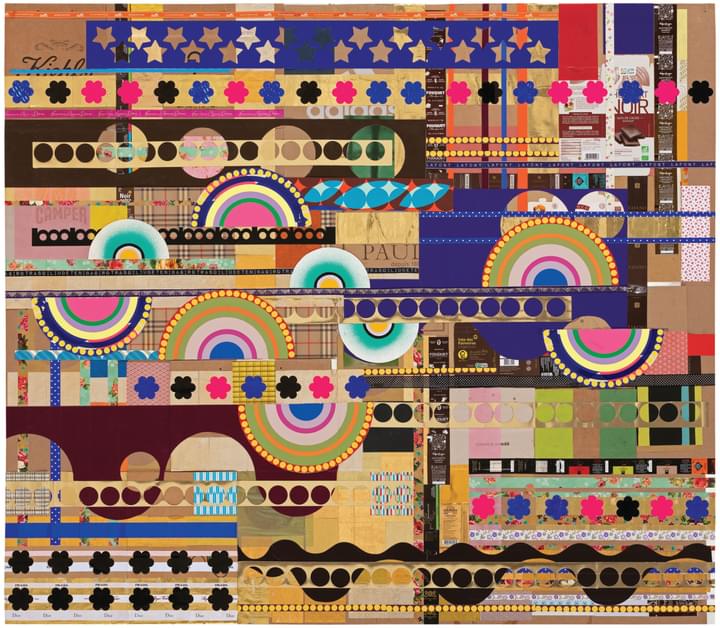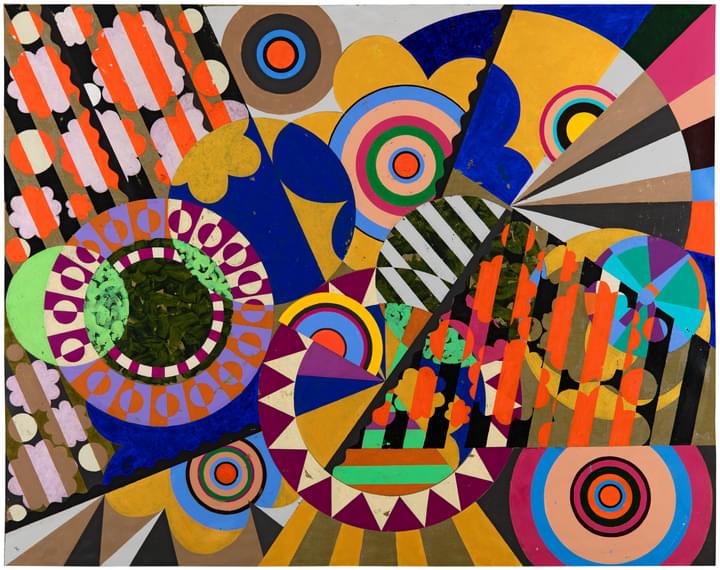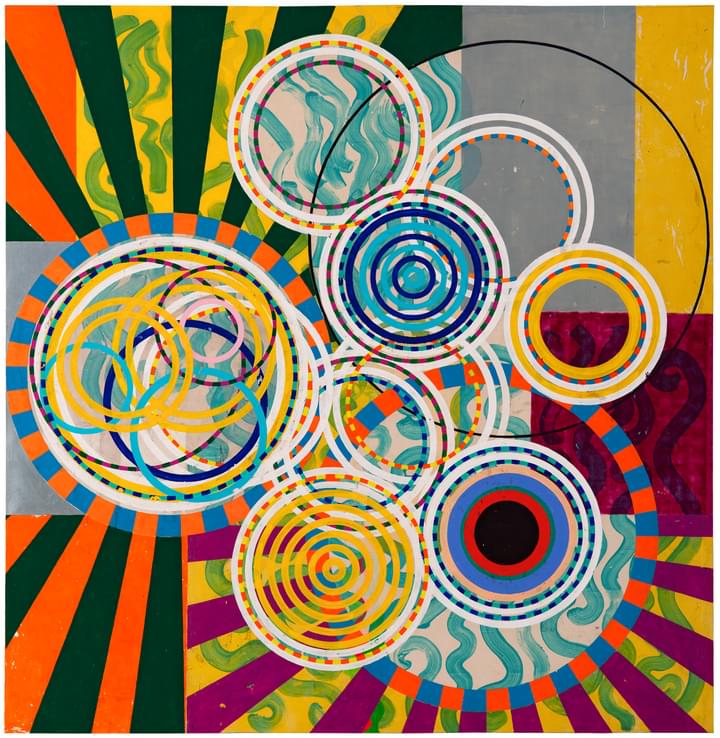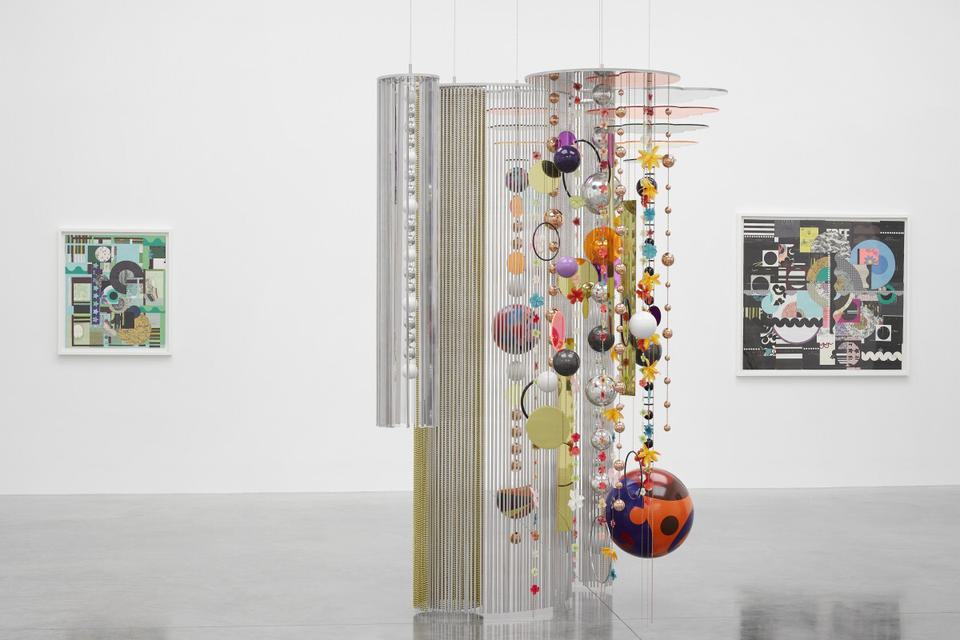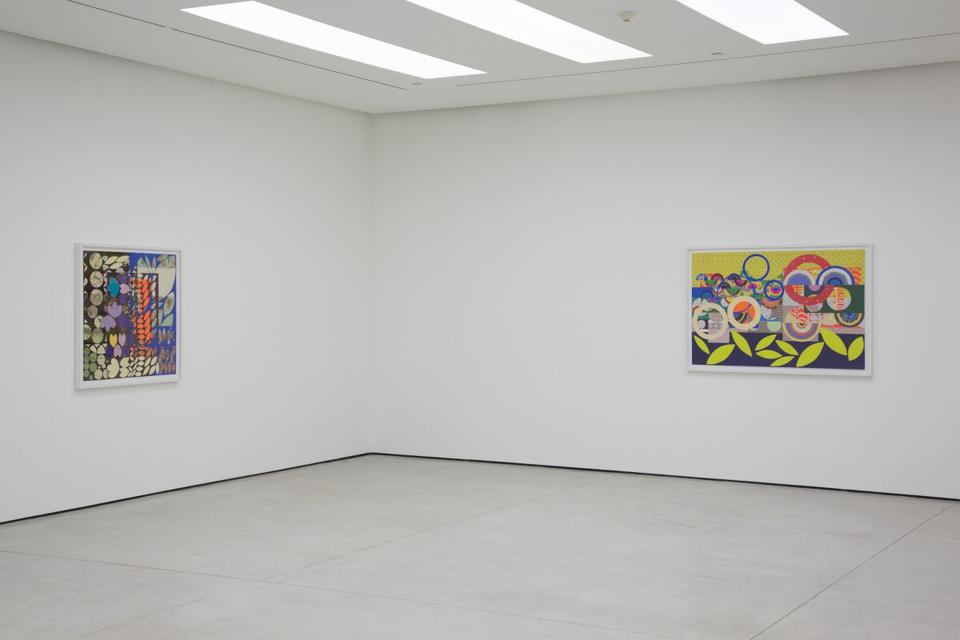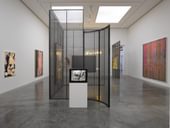Milhazes emerged as part the generation of Brazilian artists referred to as the Geração 80 (Generation 80), who were – in parallel with the pivot towards painting that occurred internationally – spurred on by their country’s newly won political freedom, as the military dictatorship came to an end. Milhazes has said, ‘I am an abstract painter and I speak an international language, but my interest is in things and behaviours that can be found in the Brazilian context.’ She combines a complex play of depth and perspective with contrasts of form and colour in ways that reveal the influence of Henri Matisse, Bridget Riley and Piet Mondrian’s late work, but also of the Brazilian Antropofagia movement of the 1920s, in particular Tarsila do Amaral, and Tropicalia.
Growing up in Rio, Milhazes recalls that it was listening to Bossa Nova music that made her want to be an artist, and relates her high contrast aesthetic to the strong sun of her surroundings, as to the extreme inequality. She dubs herself a ‘conceptual carnavalesca’: her palette and motifs mix a polyphony of print designs from popular fabrics, Baroque colonial architecture, tropical flora, its applied arts, ceramic tiles, costumes and jewellery. These are compounded in a tense and thrumming amalgamation of visual indexes that syncopate high and low culture. In the artist’s words: ‘The elements and universes external to the painting structure themselves in the colour contrasts, promoting an ocular activity, an interaction with the eyes. A healthy conflict where there are no winners – it can be even meditative.’
While collage and screen-printing provide the foundation for experimentation, there is a lively exchange between the mediums in which Milhazes works. Building on the principle of collage, she employs a decal technique in her painting, whereby acrylic paint is applied to transparent plastic, then transferred wet to canvas. Once dry, the plastic sheet is peeled back to leave a smooth, skin-like film of paint, whose strength varies depending on how many layers of paint are applied; when thin, the paint can fray as the plastic is peeled away. This process of superimposition results in compositions that are both crisp and at points torn, that seem to condense multiple moments in time into the one image, even as the intensity of the colouring and mathematical precision resists any hint of nostalgia.
The artist collates what she has called a geometry of ‘feminine overstatements’, which points to an association with handiwork traditionally done by women, such as lacemaking, sewing and beadwork. For example, in the acrylic painting Pó de arroz (2017–18) – translating from Portuguese as a powder compact for makeup – a circle motif might coil into a bull’s eye target, then revert into the detail of crochet or lace. In her collages, Milhazes will overlay an array of papers such as chocolate wrappers, wrapping paper and branded packaging, to create compositions whose internally competing graphic fields are united by a winding movement that lassoes the eye into the composition. There is a diaristic quality to the materials she collects. In Giro Horizontal (2019), the artist populates a landscape with shopping bags, Japanese paper, tape, sweet wrappers and her own print cut-outs, at once recording and entangling the language of consumerism to suggest its spiralling force. Flowers, fragmented circles and stars are derived from the decorative arts only to subvert any possibility of easy viewing, resulting in an extraordinarily demanding image, whose horizontal structure convinces the eye to persevere with the abundance of detail within.
Milhazes extends a certain defiance of gravity in sculpture. At over two metres high, the mobile works Marola, Mariola and Marilola (2010–15) are hung from drawings cut out of metal discs, which also form a kind of ‘ceiling’. Featuring characteristic motifs of the circle, the flower and the arabesque, they combine found and made materials, strung along fine, vertical threads, cascading to the floor like the beaded curtains associated with a hot climate. Like screens or dividers, the sculptures reveal and conceal, agitating the background and drawing attention to the very process of perception. Their shimmying layers can be traced back to Milhazes’s stage design for the dance production Tempo de Verão (2004), choreographed by her sister, which was conceived as a stringed chandelier floating above and in tune with the performance. The idea developed into the series of suspended Gamboa sculptures, from 2008. Executed by artisans of samba schools in Rio New, elements recycled from previous Carnival parades dangle at fixed points down the strings, cumulatively creating a cloud-like balance between weight and volume.
On a larger scale, Milhazes uses light and colour to alter the surrounding architecture, as in public commissions such as Peace and Love (2005), a site-specific installation for the London Underground, where the arches of Gloucester Road Tube Station are filled with dazzling visual cadences in the tradition of stained glass. Similarly, her ‘window paintings’, in which vinyl adhesive cutouts are applied to glass, have a transportive effect – at the Estação Pinacoteca in São Paulo, as part of her major retrospective in 2008; at the Fondation Cartier in Paris in 2009; and at the Long Museum in Shanghai in 2021. Yellow Flower Dream (2018), was created for Benesse Art Site on the island of Inujima, at the Naoshima Art House Project, Japan: a pavilion-like structure, designed by Kazuyo Sejima, comprising seventeen panels, it offers multiple viewpoints into a yellow-tinted world.
Milhazes’s first tapestry work, Rio azul (2016–18), is a panoramic, sixteen-metre-wide expanse. Woven from wool and bamboo silk in the traditional Pinton Manufacture, in Aubusson, France, the exacting design immerses the viewer in undulating rhythms of orange, violet, caramel and hot pink. Its title, meaning ‘blue river’, engulfs the piece in a sense of fluidity, colour and light, and serves as a metaphor for the diversity of Milhazes’s practice. As Paulo Herkenhoff has noted, her work ‘addresses truth criteria, fallacy, simulation, representation, geometric inexactitude, hybridism, false glitter, synthetic materials, botanical inaccuracy, shifting titles, and entropy.’
Beatriz Milhazes was born in 1960 in Rio de Janeiro, where she lives and works. She has had numerous solo exhibitions including Long Museum, Shanghai (2021); Museu de Arte de São Paulo Assis Chateaubrian (2020); Jewish Museum, New York (2016); Pérez Art Museum, Miami (2015); Centro Cultural Paço Imperial, Rio de Janeiro (2013); Museu Oscar Niemeyer, Curitiba, Brazil (2013); Museo de Arte Latinoamericano de Buenos Aires (2012); Calouste Gulbenkian Foundation, Lisbon (2012); Fondation Beyeler, Basel, Switzerland (2011); Fondation Cartier pour l’art contemporain, Paris (2009); and Pinacoteca do Estado de São Paulo (2008). In 2003 she represented Brazil at the 50th Venice Biennale.
